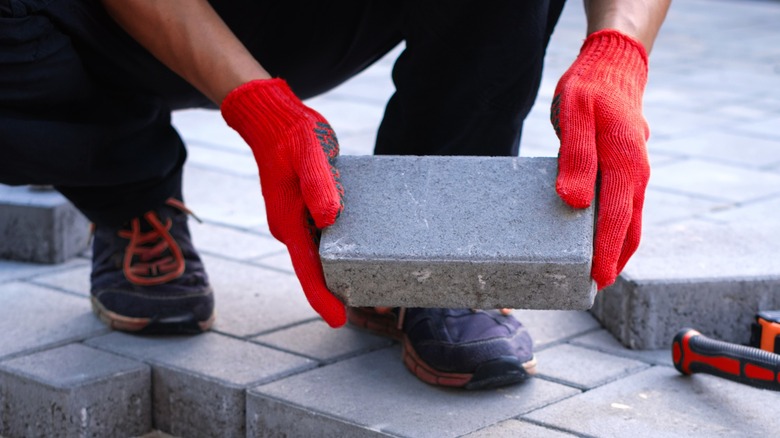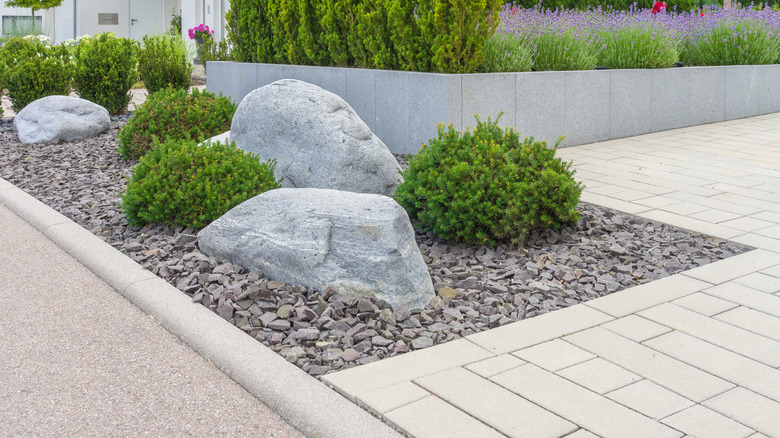The Simple Paver DIY That Takes Boring Walkways From Drab To Fab
We all know that house visitors and passersby alike form a first impression of your home before their feet even leave the curb — hence the term "curb appeal." In fact, a 2020 study by the University of Texas at Arlington found that curb appeal alone can account for up to 7% of your home's value, which shows that the exterior vibes of your home count for quite a lot. And amid the so many creative ways to increase your home's curb appeal, perhaps landscaping projects are the most essential for giving visitors that "wow" moment as they approach.
Take the pathway leading from your driveway to your front door, which is usually a guest's first interaction with your home. What can you do if you're stuck with a boring concrete walkway — and a budget too low to rip it out and start from scratch with something better? Well, you can achieve that welcoming feeling by finding walkway upgrades you can do yourself.
For instance, over on TikTok, @Sawdust2stitches shared how she DIYed her own beautiful double basketweave brick paver walkway by simply dry fitting the pavers, securing the border bricks with adhesive, and filling in the cracks with sand. When complete, this beginner-friendly DIY transforms a bland concrete sidewalk into a high-end design feature. It can be done in a weekend, with minimal tools and some elbow grease, to take your home's curb appeal to the next level. That said, there are some things to watch out for.
Here's how to DIY a paver walkway over concrete
To start with, you need to know that there are so many design and pattern ideas for your patio pavement, from freeform flagstone to elegant herringbone; begin the DIY process by choosing a pattern and material that suits your aesthetic.
Once that's done, it's time to get to work. According to this TikTok, the next step is to lay out the pavers in a dry fit (or test run) to visualize the final result and ensure you are happy with the pattern. Make adjustments to the configuration as needed. Once satisfied with your layout, use adhesive to secure the outermost pavers to the concrete, creating a solid border to hold the inner pavers in place. Finally, pour a polymer paver sand onto the walkway and use a broom to brush the sand into the cracks between the bricks, activating it with water as instructed on the packaging.
So, what would a project like this cost? A basic paver brick like in the video averages about $0.50 to $0.75 per brick, or $2.75 to $3.75 per square foot. A medium 30 x 4-foot pathway, then, would be 120 square feet, meaning paver material alone would run you $330 to $450, plus delivery. Still, compared to the average cost of $35 to $60 per square foot for a professional to install a new paver walkway (that's $4200 to $7200 total for the 30-foot walkway example), DIYing this upgrade will save you serious dough.
However, beware the pitfalls of the paver DIY
Great as this all sounds, there are some potential issues not to overlook. Some TikTok commenters were concerned with the longevity of the installation, specifically the adhesive used and concrete underneath expanding or contracting. The DIYer used an adhesive formulated for non-porous materials (which will not hold since brick, stone, and concrete are all porous) and applied pavers directly to the sidewalk.
According to experts, the proper way to install pavers over a concrete slab would be to instead use a landscape block adhesive specifically designed to secure the border pavers to the concrete. Next, they'd say to add a sheet of landscape filter fabric and thin layer of sand to even out and cushion any movement or inconsistency in the concrete before installing the inner pavers.
Another point of concern is the potential tripping hazard created at transition points, like where the walkway meets the driveway and step to the porch. When applied directly over the existing concrete, the new raised paver surface creates both an unavoidable step up from the driveway, as well as shortens the expected standard height of the first step to the porch. Both scenarios make for increased chances of an accident, especially in homes with children or those with mobility issues. If you opt to go for it, use landscape lighting, such as outdoor solar lights, to draw attention to the change in height at transitions to best avoid falls.

